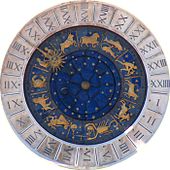Taurus (astrology)
| Taurus | |
|---|---|
 | |
| Zodiac symbol | Bull |
| Duration (tropical, western) | April 19 – May 20 (2024, UT1)[1] |
| Constellation | Taurus |
| Zodiac element | Earth |
| Zodiac quality | Fixed |
| Sign ruler | Venus |
| Detriment | Mars |
| Exaltation | Moon |
| Fall | Traditional: No planet is fall or depressed here; Modern: Uranus |
| Astrology |
|---|
 |
| Background |
| Traditions |
| Branches |
| Astrological signs |
| Symbols |
Taurus (♉︎) (Latin for bull, derived from the Greek word Ταῦρος), is the second astrological sign in the present zodiac. It spans from 30° to 60° of the zodiac. This sign belongs to the Earth element or triplicity, and has a feminine or negative polarity, as well as a fixed modality, quality, or quadruplicity. It is a Venus-ruled sign like Libra. The Moon has its exaltation here at exactly 3°. The Sun transits this sign from approximately April 21 until May 20 in western astrology.[2]
History
The sign of Taurus is associated with several myths and bull worship from several ancient cultures. It was the first sign of the zodiac established among the Mesopotamians, who called it "The Great Bull of Heaven," as it was the constellation through which the Sun rose on the vernal equinox at that time,[3] that is the Early Bronze Age, from about 4000 BC to 1700 BC.
Notes
- ^ Astronomical Applications Department 2011.
- ^ Oxford 2019.
- ^ Sołtysiak, Arkadiusz (2001). "The Bull of Heaven in Mesopotamian Sources" (PDF). Culture and Cosmos. 5: 3–21.
Works cited
- Astronomical Applications Department (2011). Multiyear Computer Interactive Almanac. 2.2.2. Washington DC: US Naval Observatory.
{{citation}}: Invalid|ref=harv(help) Longitude of Sun, apparent geocentric ecliptic of date, interpolated to find time of crossing 0°, 30°.... - Astroroom (2012). "Opposing zodiac signs: themes of the six axes". astroroom.com.
{{cite web}}: Invalid|ref=harv(help) - Oxford University Press. "Taurus, Gemini - definitions of Taurus and Gemini in English from Lexico.com".

